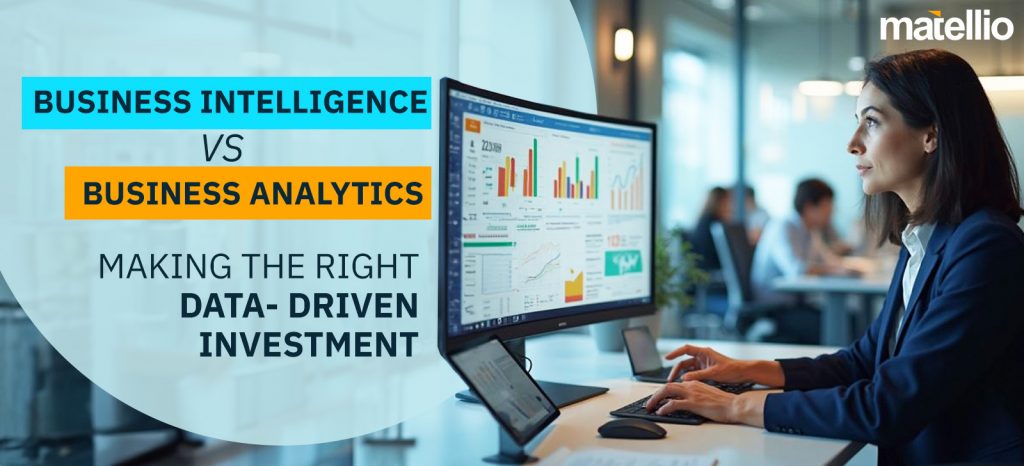
In today’s digital-driven economy, data has become one of the most powerful assets for businesses. Companies that effectively utilize data can enhance decision-making, optimize operations, and uncover new growth opportunities. However, many organizations struggle with leveraging data to its full potential, often due to a lack of clarity in choosing the right approach. Business intelligence vs business analytics plays a crucial role in this decision, as both solutions offer valuable insights but differ in methodology and application.
Business Intelligence (BI) and Business Analytics (BA) are two key strategies that help businesses harness data for improved performance. While BI focuses on historical and real-time data for operational efficiency, BA emphasizes predictive and prescriptive analytics for future planning. Many organizations either invest in the wrong solution or fail to maximize their data potential due to a lack of understanding of these approaches.
To drive meaningful results, businesses must assess their specific needs and select the right data strategy. Whether optimizing current operations or forecasting trends, aligning data-driven solutions with business objectives is essential for sustained success and profitability.
What is Business Intelligence (BI)?
Business Intelligence (BI) is a comprehensive data-driven approach that enables organizations to collect, process, and analyze historical and real-time information to make well-informed business decisions. By leveraging BI, companies can monitor key performance indicators (KPIs), optimize operational efficiency, and gain valuable insights into business performance. It primarily focuses on descriptive and diagnostic analytics, helping businesses understand past trends and the factors influencing them.
BI systems provide organizations with a centralized data framework that consolidates information from various sources, including customer interactions, financial reports, supply chain metrics, and market trends. This structured approach helps executives, managers, and decision-makers make data-backed choices to enhance productivity, profitability, and customer satisfaction.
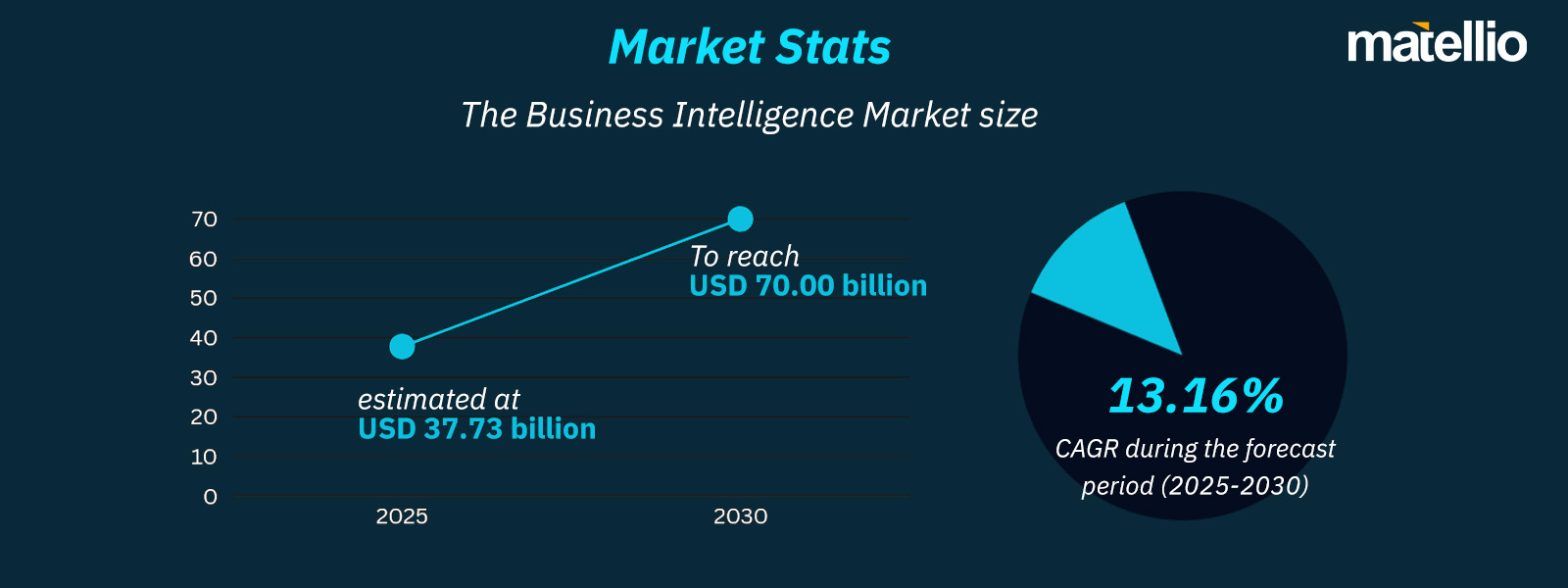 Stats: Mordor Intelligence
Stats: Mordor Intelligence
How Business Intelligence Works?
Business Intelligence (BI) platforms are designed to convert raw business data into meaningful insights that drive decision-making. The effectiveness of business intelligence vs business analytics lies in its ability to unify data from disparate sources and transform it into actionable intelligence. Businesses rely on BI platforms to automate data handling, reduce human errors, and deliver accurate, timely reports that aid strategic decision-making.
Whether tracking financial performance, analyzing customer behavior, or optimizing supply chain management, BI streamlines the entire data processing pipeline to improve business efficiency. Additionally, digital transformation services help organizations implement and integrate BI solutions seamlessly, ensuring they maximize the value of their data.
The Workflow of BI Systems
Data Collection
BI begins with collecting vast amounts of structured and unstructured data from various sources. These sources include:
- Internal databases such as Enterprise Resource Planning (ERP) and Customer Relationship Management (CRM) systems.
- Sales records, transactional data, and customer feedback logs.
- Marketing data from websites, email campaigns, and social media platforms.
- IoT-enabled devices that provide real-time operational metrics.
- Third-party sources such as industry benchmarks and external market research.
BI systems integrate these diverse data streams into a single repository, ensuring all relevant business information is captured for analysis. Business intelligence business analytics ensures that businesses make data-driven decisions by consolidating all necessary information in one place.
Data Processing
Once collected, the data undergoes processing to ensure accuracy, consistency, and usability. The steps involved in this phase include:
- Data Cleaning: Removing inconsistencies, duplicates, and incorrect values to improve reliability.
- Data Structuring: Standardizing formats and categorizing data into relevant groups.
- Data Transformation: Converting raw data into meaningful metrics, KPIs, and analytical models.
- Data Integration: Merging data from different departments to provide a holistic business overview.
This phase ensures that businesses work with high-quality, consistent data that supports accurate reporting and analytics. With business intelligence vs data analytics, organizations can better understand their operational performance by refining and processing the data effectively.
Data Visualization
After processing, BI platforms convert structured data into user-friendly formats that facilitate easy interpretation and analysis. The visualization layer of BI includes:
- Interactive Dashboards: Customizable panels that present real-time data on key performance indicators (KPIs).
- Charts & Graphs: Graphical representations of trends, correlations, and patterns in data.
- Automated Reports: Periodic reports that summarize business performance across different areas.
- Predictive Models: AI-powered visualizations that provide foresight into future trends and behaviors.
Through business analytics business intelligence, decision-makers gain immediate access to essential insights without requiring advanced technical skills, improving the efficiency of decision-making.
Real-time Monitoring
BI platforms offer continuous monitoring of business performance, enabling organizations to detect anomalies, inefficiencies, and potential risks as they occur. Key aspects of real-time monitoring include:
- Live KPI Tracking: Instant updates on sales, expenses, and operational efficiency.
- Anomaly Detection: Alerts for unusual trends, such as unexpected drops in sales or supply chain disruptions.
- Trend Analysis: Identifying emerging patterns in consumer behavior, financial health, and operational performance.
- Automated Notifications: Sending alerts to decision-makers when predefined thresholds are breached.
Real-time monitoring allows businesses to respond proactively to challenges, optimize processes dynamically, and capitalize on new opportunities as they arise. Business analytics intelligence ensures that real-time monitoring is optimized for immediate decision-making, leading to better overall business performance.
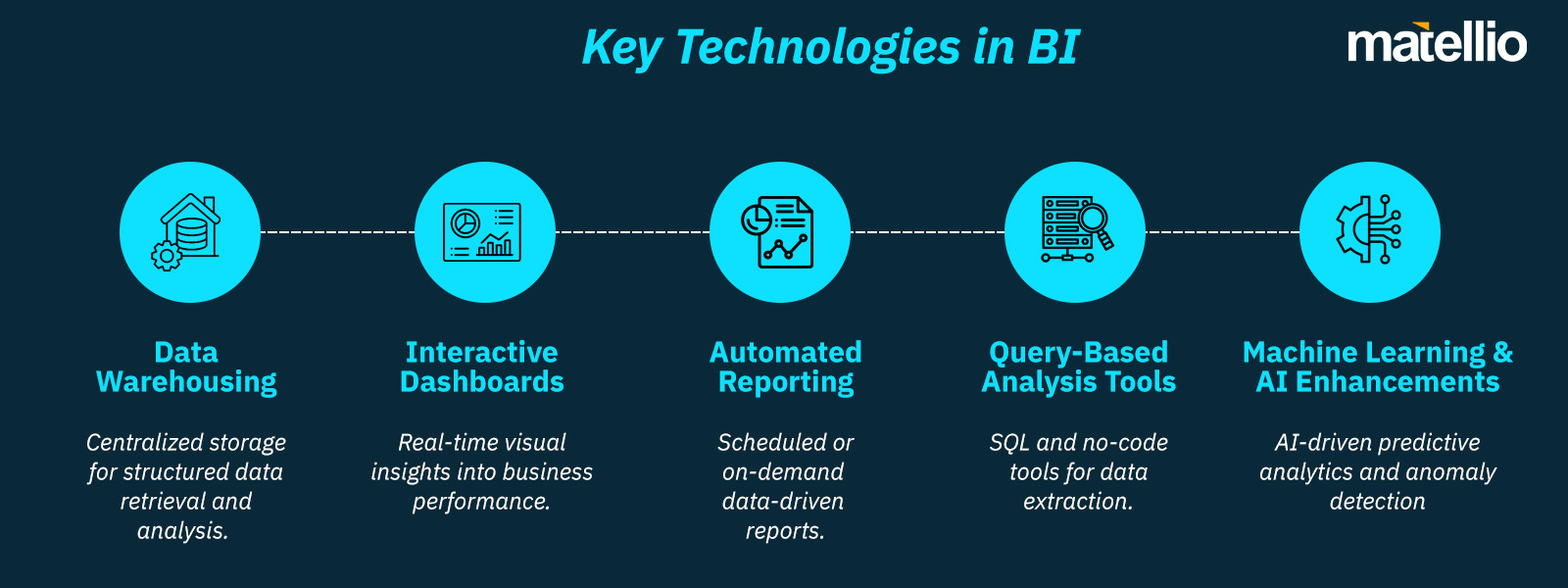
What are Business Analytics (BA)?
Business Analytics (BA) is a data-driven approach that extends beyond traditional analysis by incorporating predictive and prescriptive analytics. Unlike Business Intelligence (BI), which focuses on understanding past and present trends, BA helps businesses forecast future outcomes, optimize decision-making, and develop proactive strategies.
By leveraging advanced statistical modeling, AI, and machine learning, BA enables companies to identify patterns, anticipate market changes, and make data-backed strategic decisions that drive long-term success.
BA plays a crucial role in helping organizations stay competitive in rapidly evolving markets by equipping them with the tools needed to evaluate risks, predict customer behavior, and optimize operations. Companies that adopt BA solutions gain a significant advantage in decision-making, allowing them to adjust their strategies based on real-time insights and predictive trends.
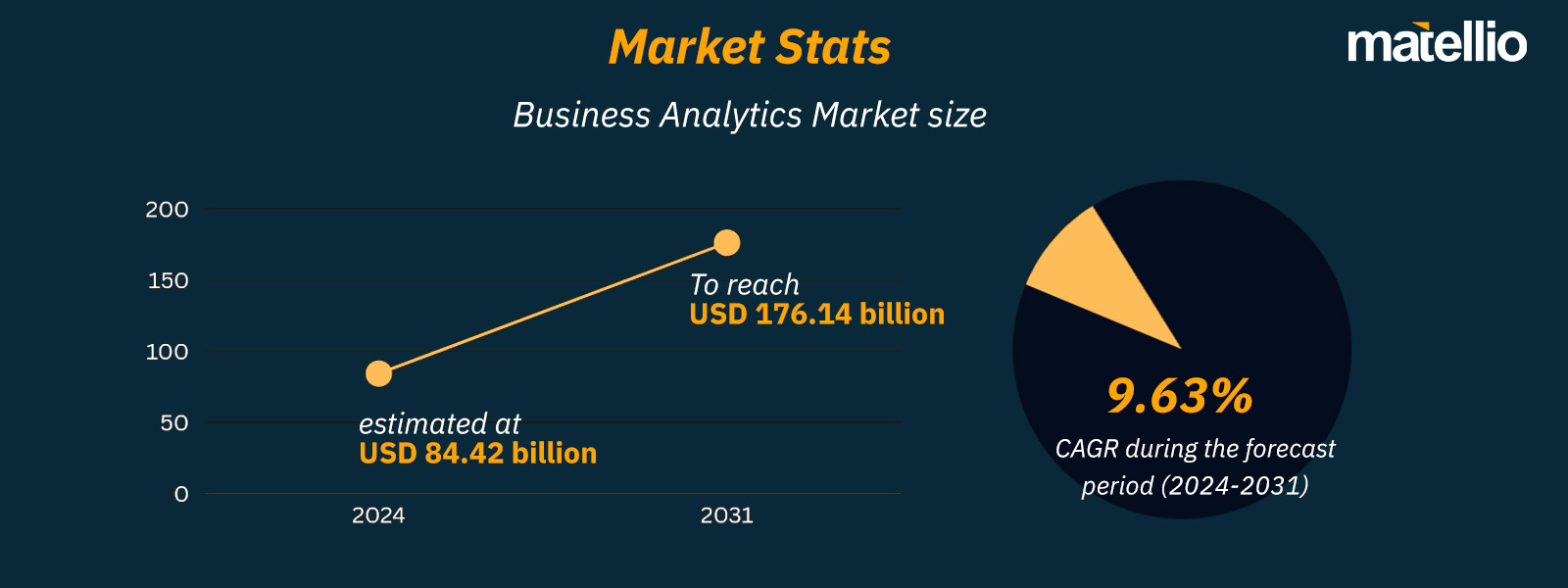 Stats: Verified Market Research
Stats: Verified Market Research
How Does Business Analytics Work?
Business Analytics (BA) helps organizations process structured and unstructured data, turning it into valuable insights for strategic decision-making. Unlike traditional analysis, BA predicts trends, identifies risks and recommends optimal actions. By leveraging statistical techniques, machine learning, and AI automation, businesses can make proactive, data-driven decisions to enhance efficiency.
BA enables businesses to anticipate challenges, optimize strategies, and automate decision-making. It processes raw data into actionable intelligence, keeping organizations competitive in a data-driven market. Additionally, data migration services facilitate smooth transitions, ensuring data integrity and seamless analytics adoption.
The Workflow of Business Analytics
Data Aggregation & Processing
The first step in business intelligence vs business analytics involves gathering and consolidating data from multiple sources, ensuring that businesses work with a unified and comprehensive dataset. The sources of data include:
- Internal Business Systems: CRM (Customer Relationship Management) platforms, Enterprise Resource Planning (ERP) software, and financial databases.
- Customer Interactions: Purchase history, customer feedback, and behavioral tracking from eCommerce platforms and mobile applications.
- Social media & Online Trends: Insights from social media platforms, web analytics, and online engagement metrics.
- IoT & Sensor Data: Real-time data from connected devices used in manufacturing, logistics, healthcare, and other industries.
- Third-Party Data Sources: Market research reports, competitor analysis, and industry benchmarks.
Once collected, the data undergoes processing and refinement, including cleaning, structuring, and categorizing it to ensure accuracy and relevance. This step helps eliminate inconsistencies, redundancies, and incomplete data points, making the dataset reliable for further analysis. Business intelligence business analytics ensures organizations work with high-quality, structured data to enhance their decision-making.
Predictive Analytics
Once processed, the data is used for predictive modeling, which allows businesses to forecast trends, anticipate customer behavior, and identify potential risks before they arise. This is achieved through:
- Statistical Forecasting: Applying historical data patterns to predict future trends.
- Machine Learning Algorithms: Using AI to continuously improve accuracy in predicting business outcomes.
- Customer Trend Analysis: Identifying market shifts and emerging customer demands.
- Risk & Fraud Detection: Recognizing anomalies in financial transactions, reducing security threats, and minimizing fraud.
With business intelligence vs data analytics, businesses can enhance predictive accuracy and create models that drive informed decision-making.
Prescriptive Analytics
Predictive analytics provides insight into what is likely to happen, but business analytics business intelligence takes it a step further by recommending the best course of action based on those predictions. It enhances decision-making by:
- Generating Strategic Recommendations: AI models suggest the most effective actions based on historical and predicted outcomes.
- Scenario Planning: Businesses can simulate different strategies and predict their impact before implementing changes.
- Optimization Models: Recommending the best pricing, marketing strategies, and operational improvements.
- Supply Chain Optimization: Helping businesses plan logistics, reduce costs, and improve efficiency in inventory management.
This approach ensures that organizations using business analytics intelligence don’t just understand potential challenges but are equipped with actionable solutions to navigate them effectively.
AI-Driven Automation
One of the key advantages of business analytics and intelligence is its ability to automate complex decision-making processes, reducing the need for manual intervention. Through AI-driven automation, businesses can:
- Automated Real-Time Decision-Making: AI-powered systems make split-second decisions, such as fraud prevention in banking or dynamic pricing in eCommerce.
- Enhance Personalization: AI tailors product recommendations and marketing campaigns based on individual customer behavior.
- Optimize Resource Allocation: AI suggests workforce scheduling, inventory replenishment, and production adjustments based on demand forecasting.
- Improve Operational Efficiency: Businesses can automate routine processes such as report generation, risk assessment, and customer segmentation.
This level of automation, when combined with business analyst vs business intelligence, allows businesses to maximize efficiency and respond swiftly to market changes.
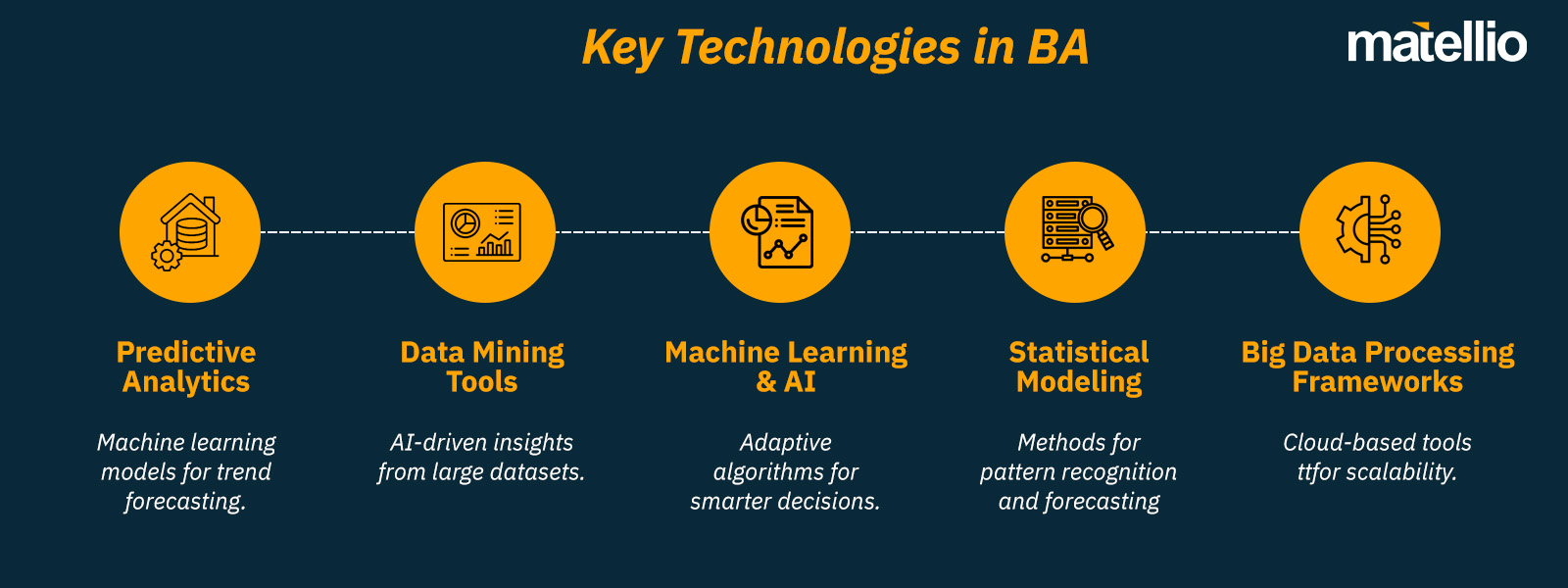
Business Intelligence vs. Business Analytics: Key Differences
Understanding the differences between business intelligence vs business analytics is essential for businesses looking to leverage data effectively. While both focus on improving decision-making, they serve different functions and are used in different scenarios. Below are the major comparison factors that distinguish them.
Core Functionality
- Business Intelligence: Business Intelligence Services focus on analyzing historical and real-time data to optimize decision-making. It helps businesses track past performance and current operations.
- Business Analytics: business analytics intelligence emphasizes predictive and prescriptive analytics, using data to identify future trends and optimize strategic decision-making.
Approach to Decision-Making
- Business Intelligence: BI is centered around descriptive analytics, helping businesses monitor KPIs and operational efficiency through real-time dashboards and reports.
- Business Analytics: It utilizes predictive modeling and machine learning to help businesses make data-driven forecasts and proactive decisions.
Data Handling & Processing
- Business Intelligence: BI works primarily with structured data sourced from databases, CRM systems, and ERP platforms, focusing on data organization and presentation.
- Business Analytics: business analytics and intelligence processes both structured and unstructured data, including social media insights and market trends, offering more flexibility in data-driven strategies.
Use Cases & Business Applications
- Business Intelligence: It is commonly used for performance tracking, financial reporting, and customer service optimization.
- Business Analytics: BA is widely applied in predictive modeling, trend forecasting, and customer behavior analysis to improve market positioning.
Users & Key Stakeholders
- Business Intelligence: BI is primarily used by executives, managers, and decision-makers who need historical and real-time reports to enhance operational efficiency.
- Business Analytics: BA is used by data scientists, analysts, and strategists who require deep analytics and predictive insights to shape future business strategies.
Technology & Tools
- Business Intelligence: Business intelligence relies on data visualization tools, dashboards, and automated reporting systems such as Tableau and Power BI.
- Business Analytics: BA involves machine learning, predictive analytics, and AI-driven data mining to process complex datasets.
Strategic vs. Tactical Insights
- Business Intelligence: BI provides tactical insights, enabling businesses to optimize current operations and streamline workflows.
- Business Analytics: It offers strategic insights, predicting market trends and optimizing long-term planning.
Final Thought
Both business intelligence vs business analytics provide immense value, but they cater to different needs. BI is ideal for businesses looking to optimize real-time operations and monitor performance, while BA is better suited for companies seeking data-driven forecasts and strategic insights. However, integrating both solutions can provide a comprehensive approach to data-driven decision-making. Our experts specialize in helping businesses implement business analytics and business intelligence to develop customized strategies aligned with their goals.
Unlock the Power of Data—Find the Right Strategy for Your Business Today
How to Determine the Right Choice for Your Business
Choosing between business analyst vs business intelligence depends on a company’s goals, operational structure, and decision-making requirements. Businesses must evaluate their needs to determine which solution aligns best with their strategy. Below are key scenarios to guide the decision-making process:
 If Your Business Needs Operational Optimization
If Your Business Needs Operational Optimization
BI vs. business analytics helps businesses streamline workflows, track KPIs, and monitor efficiency in real-time. Businesses relying on operational excellence and performance tracking can benefit from automated insights and real-time data visualization.
 If Your Business Needs Future Predictions & Trend Forecasting
If Your Business Needs Future Predictions & Trend Forecasting
BI vs analytics is useful for forecasting market trends, customer behavior, and business risks. Organizations looking to stay ahead of competitors can leverage predictive analytics to anticipate changes and proactively adjust strategies.
 If You Need Real-Time Monitoring & Insights
If You Need Real-Time Monitoring & Insights
Business analytics and business intelligence provide dashboards for tracking financial and operational performance. This helps businesses access real-time data that allows for agile decision-making and improves overall efficiency.
 If You Want a Data-Driven Strategy & Risk Assessment
If You Want a Data-Driven Strategy & Risk Assessment
Analytics vs business intelligence supports predictive analysis for strategic planning and risk management. Companies in dynamic industries can use BA to mitigate risks, develop contingency plans, and refine long-term strategies.
 If You Need a Comprehensive View of Data
If You Need a Comprehensive View of Data
A combination of business intelligence vs business analytics ensures businesses benefit from both real-time and predictive insights. By integrating both solutions, organizations can optimize daily operations while planning for future growth.
 If You Rely on Historical Data for Performance Tracking
If You Rely on Historical Data for Performance Tracking
Business intelligence vs data analytics helps companies analyze past performance trends effectively. Businesses focusing on financial performance, sales trends, or operational benchmarking rely on BI to provide clear, data-backed reporting.
 If You Need Automated Decision-Making Capabilities
If You Need Automated Decision-Making Capabilities
Business analytics intelligence integrates AI to automate complex decision-making processes. Companies looking to scale operations and improve productivity can implement AI-driven analytics to streamline workflows and enhance efficiency.
 If You Want to Personalize Customer Experiences
If You Want to Personalize Customer Experiences
Business analytics and intelligence help businesses analyze customer data to refine personalized marketing campaigns. Retailers, eCommerce brands, and service providers can use BA to improve customer segmentation, optimize engagement strategies, and drive higher conversions.
 Conclusion
Conclusion
BI and BA each play a crucial role in helping businesses maximize the value of their data. While business analyst vs business intelligence focuses on structured reporting, enhances predictive modeling. Choosing the right approach depends on business goals, operational needs, and the level of data-driven automation required.
Struggling to Choose Between BI and BA? Let Our Experts Guide You!
BI and BA Use Cases in Business
Leveraging data effectively is key to business growth and efficiency. Business Intelligence Consultation enables organizations to implement BI for real-time insights and operational improvements, while BA focuses on predictive analytics for strategic planning. Understanding their use cases helps businesses maximize data-driven decision-making and stay competitive.
Business Intelligence Use Cases:
Sales Performance Monitoring
Tracking real-time revenue, sales trends, and customer engagement through business intelligence business analytics helps businesses identify top-performing products, sales cycles, and consumer behavior patterns, leading to strategic pricing adjustments.
Financial Reporting
Automating financial report generation for audits and compliance with business intelligence vs data analytics reduces human errors and improves transparency, ensuring organizations make informed budgeting decisions.
Customer Support Analytics
Analyzing customer interactions, support tickets, and response times through business analytics business intelligence enables businesses to enhance service quality, streamline customer support processes, and improve satisfaction.
Supply Chain Optimization
Monitoring inventory levels and detecting inefficiencies using business analytics intelligence helps optimize procurement, manage supplier relationships, and reduce operational costs.
Operational Workflow Tracking
Identifying bottlenecks and inefficiencies in workflows through business analytics and intelligence ensures organizations can leverage real-time insights to improve workforce productivity and automate repetitive tasks.
Employee Performance Insights
Measuring KPIs and workforce efficiency with business analyst vs business intelligence allows management to assess employee performance, improve training programs, and boost overall productivity.
Business Analytics Use Cases:
Customer Churn Prediction
Retaining customers is essential for business growth. Business analytics business intelligence analyzes customer interactions and behaviors to identify churn risks. Machine learning detects warning signs, allowing businesses to implement retention strategies like personalized offers and loyalty programs.
Market Demand Forecasting
Managing demand fluctuations is crucial to avoid overproduction or shortages. Business analytics intelligence uses predictive analytics to analyze sales trends and external factors, helping businesses optimize supply chains and adjust inventory efficiently.
Pricing Optimization
Optimizing pricing strategies boosts profitability. Business analytics and intelligence help businesses assess market trends, competitor pricing, and customer behavior, enabling data-driven pricing adjustments that maximize revenue and maintain competitiveness.
Risk Management & Fraud Detection
Financial security is critical in preventing fraud. Business analyst’s vs business intelligence apply AI-powered anomaly detection to identify irregular financial transactions, flag suspicious activity, and ensure compliance with industry regulations.
Targeted Marketing Campaigns
Personalized marketing improves engagement and conversion rates. Legacy system migration allows businesses to segment audiences based on behavioral analytics, ensuring marketing efforts reach the right customers with relevant content.
Product Development Insights
Understanding market needs ensures successful product launches. Business analytics business intelligence analyzes customer feedback and competitor performance to identify gaps, helping businesses refine features and predict new product success.
How Can Businesses Successfully Implement BI or BA?
Successfully integrating Business Intelligence (BI) or Business Analytics (BA) requires a structured approach, ensuring businesses maximize data insights for strategic decision-making and operational efficiency. Below are essential steps for seamless implementation, along with expert guidance on achieving long-term success.
Define Clear Objectives
- To achieve meaningful outcomes, businesses must first define their objectives. Identifying whether BI, BA, or both are required depends on company goals—whether the focus is on real-time performance tracking, future trend predictions, or a combination of both.
- Clear objectives ensure that data-driven strategies align with business priorities. Our team works closely with businesses to assess their unique challenges and tailor solutions that align technology with their strategic goals.
- We provide actionable insights that enhance decision-making, helping businesses optimize operations while staying competitive. With technology consulting services, we help businesses identify the best data strategies to maximize efficiency and performance.
Assess Data Infrastructure
- A strong data infrastructure is essential for the seamless integration of BI and BA tools. Organizations must evaluate their current systems, data sources, and storage capabilities to ensure scalability and security.
- Without a solid foundation, data inconsistencies and integration challenges may arise. We conduct a thorough assessment of your existing infrastructure and recommend scalable solutions that align with business growth.
- Our approach ensures seamless integration with databases, cloud platforms, and legacy systems, providing businesses with a robust data foundation. Through cloud integration services, we enable businesses to centralize data storage, enhance accessibility, and streamline operations.
Select the Right Tools & Technologies
- Choosing the right BI and BA tools is crucial for extracting actionable insights. Businesses must evaluate factors such as ease of use, scalability, and integration capabilities when selecting a platform.
- The right technology stack enhances data accessibility, visualization, and analysis. We guide businesses in selecting and implementing advanced BI and BA tools, ensuring optimal utilization of data.
- Our expertise spans across multiple platforms, from AI-driven analytics solutions to interactive dashboards, empowering businesses to leverage data effectively. Business analytics business intelligence ensures that businesses adopt solutions that enhance decision-making and data-driven performance.
Train Employees & Foster a Data-Driven Culture
- Adopting BI and BA tools requires a data-driven mindset among employees. Teams must be equipped with the knowledge to interpret data insights, enabling them to make informed decisions.
- Training programs and continuous learning initiatives foster a culture where data is integral to operations. We provide customized training sessions to help employees understand BI and BA tools, ensuring smooth adoption.
- Our workshops and hands-on training enable teams to use data insights effectively, improving decision-making and operational efficiency. With a strong emphasis on business analytics intelligence, we help businesses develop an internal data-driven culture that maximizes the value of their analytics investments.
Ensure Security & Compliance
- Handling vast amounts of business data requires strict security measures and compliance with industry regulations. Businesses must implement data governance policies to prevent breaches, ensure ethical data usage, and meet regulatory standards like GDPR and CCPA.
- Our security-first approach ensures data integrity through encryption, access controls, and compliance frameworks. We help businesses implement robust security measures that safeguard sensitive information while maintaining regulatory compliance.
- By incorporating business analytics and intelligence, we ensure that data security aligns with business objectives and industry standards.
Custom BI & BA Solutions Tailored for Your Business—Let’s Build Your Data Future!
How Matellio Can Help You Choose Between Business Intelligence and Business Analytics?
Making the right choice between Business Intelligence (BI) and Business Analytics (BA) is crucial for businesses aiming to maximize data-driven decision-making. While BI provides historical and real-time insights for operational efficiency, BA focuses on predictive analysis for future planning. Our experts at Matellio specialize in helping businesses implement the right strategy based on their unique requirements. Here’s how we can guide you:
- Our team analyzes your business goals, data infrastructure, and operational needs to determine whether BI, BA or a combination of both is the right fit. We provide tailored recommendations to align your data strategy with business objectives.
- From setting up BI dashboards for real-time monitoring to integrating BA predictive models for market trend analysis, we develop and deploy data solutions that optimize business performance and enhance decision-making capabilities.
- We ensure that BI and BA solutions integrate effortlessly with your existing ERP, CRM, cloud platforms, and legacy systems to create a unified data ecosystem that improves efficiency and data accessibility. Our expertise in AI integration services ensures that businesses can leverage advanced automation and machine learning capabilities for enhanced analytics.
- Data governance is a priority in both BI and BA implementations. We help businesses establish robust security frameworks, compliance with industry standards, and secure data storage solutions to ensure data integrity and regulatory adherence.
- We provide hands-on training sessions and ongoing technical support, ensuring that your teams can effectively utilize BI and BA tools to drive business growth. Our experts assist in fostering a data-driven culture within your organization.
Not sure whether Business Intelligence or Business Analytics is right for your business? Fill out the form and connect with our experts today to build a data strategy that drives real results.
Business Intelligence vs Business Analytics Services -FAQ’s:
Q1. How do I determine whether my business needs Business Intelligence or Business Analytics?
Choosing between Business Intelligence vs. Business Analytics depends on your business goals. BI focuses on real-time data tracking, reporting, and operational insights, while BA emphasizes predictive modeling and future trend analysis. If your priority is monitoring past and present performance, BI is ideal. If you need data-driven forecasting and strategic planning, BA is the right choice. Our experts can assess your requirements and guide you toward the best solution.
Q2. Can Business Intelligence and Business Analytics be used together?
Yes, many businesses integrate business intelligence into business analytics to gain a comprehensive data strategy. BI provides real-time operational insights, while BA helps forecast future trends and optimize decision-making. Combining both allows businesses to improve efficiency and long-term planning simultaneously.
Q3. How long does it take to implement BI or BA solutions?
The implementation timeline varies based on factors such as data volume, integrations, and customization need. BI solutions typically take a few months to deploy, while BA solutions, which involve machine learning and predictive modeling, may require additional time. Our team provides a detailed roadmap to ensure a seamless transition.
Q4. What industries benefit from BI and BA?
Business analytics intelligence and BI are valuable across industries, including retail, finance, healthcare, and manufacturing. BI improves operational efficiency with real-time dashboards, while BA helps businesses predict customer behavior, optimize pricing, and reduce risks. Our tailored solutions ensure your industry-specific needs are met.
Q5. How secure are BI and BA tools?
We implement industry-leading security measures, including data encryption, role-based access controls, and compliance with GDPR and CCPA. Whether using BI for operational insights or BA for predictive analytics, our solutions are designed to maintain data integrity and protect against cyber threats.
Q6. Can BI and BA solutions integrate with my existing systems?
Yes, we ensure seamless integration with your CRM, ERP, cloud platforms, and databases, creating a unified data ecosystem. Our team specializes in building scalable BI and BA solutions that work effortlessly with your existing infrastructure.
Q7. What are the costs involved in implementing BI or BA?
The cost of BI and BA solutions depends on data complexity, the number of integrations, and customization requirements. Our team offers cost-effective solutions tailored to your business needs, ensuring high ROI with advanced data-driven insights.
 If Your Business Needs Operational Optimization
If Your Business Needs Operational Optimization If Your Business Needs Future Predictions & Trend Forecasting
If Your Business Needs Future Predictions & Trend Forecasting If You Need Real-Time Monitoring & Insights
If You Need Real-Time Monitoring & Insights If You Want a Data-Driven Strategy & Risk Assessment
If You Want a Data-Driven Strategy & Risk Assessment If You Need a Comprehensive View of Data
If You Need a Comprehensive View of Data If You Rely on Historical Data for Performance Tracking
If You Rely on Historical Data for Performance Tracking If You Need Automated Decision-Making Capabilities
If You Need Automated Decision-Making Capabilities If You Want to Personalize Customer Experiences
If You Want to Personalize Customer Experiences Conclusion
Conclusion

